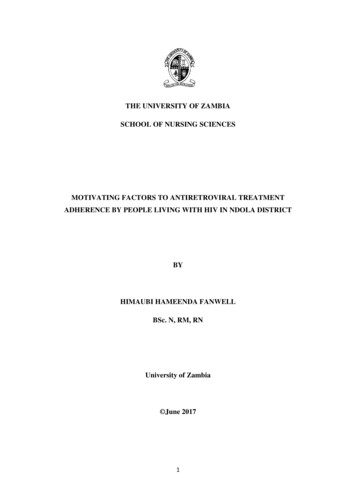
Transcription
THE UNIVERSITY OF ZAMBIASCHOOL OF NURSING SCIENCESMOTIVATING FACTORS TO ANTIRETROVIRAL TREATMENTADHERENCE BY PEOPLE LIVING WITH HIV IN NDOLA DISTRICTBYHIMAUBI HAMEENDA FANWELLBSc. N, RM, RNUniversity of Zambia June 20171
MOTIVATING FACTORS TO ANTIRETROVIRAL TREATMENTADHERENCE BY PEOPLE LIVING WITH HIV IN NDOLA DISTRICTBYHIMAUBI HAMEENDA FANWELLBSc. N, RM, RNUniversity of ZambiaJune 20172
MOTIVATING FACTORS TO ANTIRETROVIRAL TREATMENTADHERENCE BY PEOPLE LIVING WITH HIV IN NDOLA DISTRICTBYHIMAUBI HAMEENDA FANWELLBSc. N, RM, RNA dissertation submitted in partial fulfilment of the requirements for the Degreeof Master of Science in Nursing, Maternal and Child health3
NOTICE OF COPYWRIGHTAbout Himaubi Hameenda Fanwell. All rights reservedAndy Flat 1Luangwa Close,Town Centre,Ndola Zambia097 7 884 835himaubif@gmail.comReprinting / or reproducing and downloading, display of this material withoutprior permission from the owner is prohibited. All other rights reserved.October 2017 2017 by Fanwell Hameenda Himaubii
DECLARATIONI Fanwell Hameenda Himaubi, hereby declare that this Dissertation represents myown work and has not been presented either wholly or partially for a Degree at theUniversity of Zambia or any other University. I further declare that all the sources Ihave cited have been indicated and acknowledged using complete references.Signature (Candidate) Date .Signature (Supervisor) . Date ii
CERTIFICATE OF COMPLETION OF DISSERTATIONI Doctor Catherine M Ngoma, having supervised and read this Dissertation issatisfied that this is the original work of the author under whose name it is beingpresented. I confirm that the work has been completed satisfactorily and approved itfor final submission.Signature Date .SupervisorHead of DepartmentName . Date .Department of Midwifery, Women and Child Health, School of NursingSciences, University of Zambiaiii
CERTIFICATE OF APPROVALThe University of Zambia, School of Nursing Sciences approves this Dissertation byFanwell Hameenda Himaubi, in partial fulfilment of the requirements for the awardof Master of Science in Nursing Degree, Maternal and Child Health at the Universityof Zambia.Examiner IName : .Signature . Date .Examiner IIName : ,,, Signature . Date .Examiner IIIName : Signature . Date .iv
DEDICATIONTo my wife and Children who missed my Tender care during my study periodespecially Malawo at his tender age, Dad Malawo Mosture Himaubi whopassed on while I was still studying.v
ACKNOWLEDGEMENTI am very grateful to Dr. Ngoma Catherine for the untiring support she gaveme having taken over from the late Dr. Prudentia Mweemba (MHSRIP) amIndebted. I greatly appreciate for her (Dr. Ngoma) continued efforts toperfect my work. I am thankful too for the support rendered by Ms. WahilaRuth.Special thanks go to my friend and teacher Mr. F. Chapima for bringing toremembrance the forgotten SPSS program use and not forgetting KedrickSikaona for the statistical help I received.Further acknowledgements go to Dr. Peter Mwaba for the offer of support insponsorship through the Ministry of Health and the question of us to write theroad map for nursing if we as a group of five (5) were to be sponsored. This Iam grateful as it came to pass that a pronouncement was made for the birthof a Directorate of Nursing while I was studying.Many thanks to you allvi
ABSTRACTIntroductionAdherence to Antiretroviral Treatment (ART) is a major global public healthchallenge and a barrier in the management of HIV. Without adequate adherence,antiretroviral agents are not maintained at sufficient concentrations to suppressHuman Immune Virus (HIV) replication in infected cells and to lower the plasmaviral load. In addition to being associated with poor short-term virological response,poor adherence to antiviral medication accelerates development of drug-resistant HIV.ObjectivesThe main aim of the study was to determine motivating factors to ART adherence bypeople living with HIV in Ndola district.MethodologyThis was a cross sectional study conducted in Ndola urban district. Convenientsampling method was used to select 150 respondents. Face to face interviews using astructured, interview schedule was used to collect data from the respondents.Data wasanalyzed using IBM SSPS version 24.0. Descriptive statistics and inferential statisticswere applied and Chi-square test was used to test associations between the dependentvariable and independent variables. Level of significant was set at 0.05 % with 95%confidence interval.ResultsSeventy-six (76%) of the respondents were aged above 34 years, 63.3% were females,while 54% had attained secondary school education. Most respondents (83%) wereself-employed and 68% earned an income above K1, 500. The adherence rate wassuboptimal (63.3%)Most of the respondents (77.7%) had lived with the HIVinfection for more than 19 years, 93.6% were able to disclose their status and 59.3%lived with their children. More than three quarters (84%) of the respondents did notknow the benefits of taking Antiretrovirals (ARVs) and 84% did not know theimportance of ART adherence. After initiation of ART, 74% of the respondents‘health status improved and 81.5% received treatment daily while 18.5% took drugstwice in a day. Special instructions on dietary restrictions were given to 61.3%respondent, 67.8% were told to take extra fluid and 33% respondents‘ were givenrestrictions for both. Most respondents (56.7%) initiated ART when their CD4 countvii
was less than 350/mm3, while 43.3% initiated ART when the CD4 count was 350/mm3.Most respondent were on a one regime treatment (75.3%) and 55.4% had someone toremind them when to take their medications. Of the persons to remind the respondents35.3% were their spouses, 74% of the respondents‘ reported that they sometimesforgot to take their ARVs. The reasons for forgetting to take drugs included beingbusy (9.3%), intoxicated with alcohol, (5.3%), feeling stigmatized (2.7%), in a hurry (0.7%) while 20% did not give any reason. Further analysis of data did not show anyrelationship between ART adherence and other variables except the level of education(P value 0.016).ConclusionThe study findings revealed that adherence to ARVs was influenced by the knowledgeof the benefits of taking ARVs, importance of taking ARVs and the level of educationof the respondents. There is need therefore to strengthen and continuously provideinformation, education and communication by all the relevant stakeholders using bothprint and electronic media on ART adherence.Keywords: Motivating factors, antiretroviral treatment, adherence, people living withHIVviii
TABLE OF CONTENTContentPage NoNotice of Copyright .iDeclaration .iiCertificate of completion iiiCertificate of approval .ivDedication .vAcknowledgement . viAbstract .viiTable of content ixList of Tables .xiiiList of Figures . .xivList of Abbreviations xvCHAPTER ONE1.0 Introduction .11.1 Background information . .11.2 Statement of the problem . .31.3 Justification of the study . .41.4 Social cognitive theory . 41.5 Research question .81.6 Research Objectives .8 .81.8 Conceptual Definition of Terms . . . .81.7 Hypothesis1.9 Study variables . .ix9
CHAPTER TWO2.0 Literature review . .12 . .122.2. Adherence rates to ART . . .12 182.1 Introduction2.3 Predictors of adherence2.3.1 Stigma and Discrimination2.3.2. Knowledge2.3.3 Age 18 . 20 . 20 2.3.4 Substance Abuse Related challenges2.3.5 Socioeconomic Challenges20 . 212.3.6 Cultural Beliefs . 212.3.7 Service related Factors . 222.3.8 Patient related Factors . 222.4 Conclusion . 25CHAPTER THREEMethodology3.0 Introduction 263.1 Research design . 263.2 Research setting . 263.3 Study population . 263.3.1 Inclusion criteria . 273.3.2 Exclusion criteria . 273.4 Sampling Method . 273.5 Sample Size . 273.6 Data collection tool . 283.6.1 Validity of the tool . 283.6.2 Reliability of the tool . 28x
3.7 Data collection technique . . .28 .293.8 Data processing and analysis 293.10 Ethical and legal consideration . .293.9 Pilot studyCHAPTER FOUR . .30 .30 .304.3 Presentation of findings .304.0 Data analysis and presentation of findings4.1 Introduction4.2 Analysis 30 324.3.3 Section C Predictors to ART among the Respondents 324.3.1 Section A Demographic Data of the Respondents4.3.2 Section B adherence level to ART by the Respondents4.4 Section D Associations between the Dependent andIndependent Variables . 384.5 Summary of findings 41CHAPTER FIVE 43 .43 435.0 Discussion of Findings5.1 Introduction5.2 Demographic Characteristics of the Respondents5.3 Discussion of findings according to variables . 445.3.1 Adherence level to ART by the respondents . 445.3.2 Predictors to ART among the respondents 5.4 Associations between the Dependent and Independent Variables5.5 Relationship between Research Theory and the Study Result 4552525.6 Implications for Nursing . 52 . 535.7 Conclusion and Recommendations5.8 Dissemination and utilization of findingsxi . 54
. .54 565.9 Limitations and strength of the studyReferencesAPPENDICESAppendix 1: Information Sheet .71Appendix 2: Informed Consent .73Appendix 3: Study Budget .74Appendix 4: GanttChart 78Appendix 5: Questionnaire .80Appendix 6: Permissions . .86xii
LIST OF TABLESTablePage NoTable 1: Total numbers of lost to follow up clientsfrom 2010 to 2015 .4Table 2: Variable, indicator and cut off points 10Table 3: Respondents adherence levels to ART 32Table 4: Responses on the benefits of taking ARVs 33Table 5: Respondents responses on the importance of adherence .33Table 6a: Respondents who forgot to take medication . 36Table 6b: Reasons for forgetting to take medication by respondents . 36Table 7: Respondents responses on whether staff were welcomingat the ART centers . 37Table 8: Respondents responses on availability of ARVs at ART centers38Table 9: Association between ART adherences and the respondents‘knowledge levels about ART . .38Table 10: Association between ART adherences and the respondents‘age at last birth day .39Table 11: Association between ART adherences and the respondents‘levels of education . 39Table 12: Association between ART adherences and the respondents‘employment status . 40Table 13: Association between ART adherences and the respondents‘Relation of whom living with in the house .xiii40
LIST OF FIGURESFiguresPage NoFigure 1: Social cognitive theory theoretical framework .7Figure 2: Modified social cognitive theory as applied to this study .7Figure 3: Demographic Data . 31Figure 4: Respondents Duration of HIV status and Disclosure 32Figure 5: Respondents Health status, frequency of taking drugs andSpecial instructions during treatment . 34Figure 6: Respondents CD4 at the initiation and other parameters 35Figure 7: responses on who reminded respondents to take medicines 35Figure 8: Respondents on whether they experienced side effectsand missed appointment . 37xiv
LIST OF ABBREVIATIONSAACTGAdult AIDS Clinical Trials GroupAIDSAcquired Immunodeficiency SyndromeARTAntiretroviral TreatmentARVAntiretroviralCDCCentre for Disease ControlCINAHLCumulative Index of Nursing and Allied Health LiteratureCRSSSCreative Research System Survey SoftwareCSOCentral Statistical OfficeHAARTHighly active antiretroviral treatmentHAPCOHIV/AIDS Prevention and Control OfficeHBACHome-Based Aids CareHCHealth CentreHIVHuman immune virusIECInformation education and communicationIQRInterquartile RangeMEMSMicro Electro Mechanical SystemsMoHMinistry of HealthMPRMonthly Prescribing ReferenceNANDA:North American Nursing Diagnosis AssNGONon-Governmental OrganizationNOC:National outcome classificationNOCTEAt nightNNRTINon-nucleoside reverse transcriptase inhibitorNRTINucleoside reverse transcriptase inhibitorOIOpportunistic InfectionsPCPPneumocystis carinii pneumoniaxv
UNAIDSUnited Nations Programme on acquired immune deficiencysyndromeUNZAUniversity of ZambiaUSAUnited States of Americaxvi
xvii
CHAPTER ONE1.0IntroductionAccording to Center for Disease Control (CDC) (2012) the importance ofconceptualizing treatment adherence broadly should include early engagement in careand sustained retention in care. The concept of an HIV ―treatment cascade‖ has beenused to describe the process of HIV testing, linkage to care, initiation of effectiveART, adherence to treatment, and retention in care. Evidence has shown thatmaintaining high levels of adherence to ART is a critical determinant of long-termoutcome in HIV infected patients (Ross et al., 2011). Non adherence to ART maylead to loss of virologic control, drug resistance and loss of future treatment options(Cohen, 2011). Each and every step in the treatment cascade is very important inorder to achieve optimal clinical outcomes and to realize the potential public healthbenefit of treatment and prevention. To avoid the emergence of the resistant strains ofthe virus, the World Health Organization (WHO) recommends at least 95% ofadherence to ART (Stone et al., 2001). Based on these facts, the importance ofadhering to ART has been widely publicized and accepted as a critical element in thesuccess of slowing down the rate at which HIV makes copies of itself.1.1Background InformationChapter one provides background information on motivating factors to anti-retroviraltherapy (ART) adherence by people living with HIV, statement of problem, studyjustification and the theory that will guide the study. The research question, researchobjectives, hypothesis, conceptual and operational definitions and major studyvariables are indicated.Adherence to ART is a major global public health challenge and a barrier in themanagement of HIV. Without adequate adherence, ARV are not maintained atsufficient concentrations to suppress HIV replication in infected cells and to lower theplasma viral load. In addition to being associated with poor short-term virologicalresponse, poor adherence to antiviral medication accelerates development of drugresistant HIV (WHO, 2003). Most of the ARVs have dietary restrictions and some1
have short or long term side effects. These could deter HIV positive clients fromadhering to the treatment regimens.ART is a combination of several medicines used to slow down the rate at which HIVmakes copies of itself (multiplies) in the body (Grant et al.,2010). A combination ofthree or more ARV medicines has been found to be more effective than just one. Thisis referred to as ―anti-HIV cocktail ―and is the standard treatment for HIV infection.There are five classes of drugs which are used to treat HIV infection and theseinclude; 1)Nucleoside/nucleotide reverse transcriptase inhibitors also callednucleoside/nucleotide analogssuch asAbacavir, Emtricitabine,Tenoforvir,Lamivudine and Zidovudine, 2) Non-nucleoside reverse transcriptase inhibitors suchas Efavirenz and Nevirapine, 3) Protease inhibitors such as Lopinavir, Indinavir andRitonavir, 4) Entry inhibitors such as Enfuvirtide and Maraviroc, 5) Integraseinhibitors such as Dolutegravir and Raltegravir.ART is a life-long treatment that helps people with HIV live longer, healthier lives.Before starting ART, people with HIV discuss the benefits and risks of ART withtheir health care providers. They also discuss the importance of medication adherence(taking HIV medicines every day and exactly as prescribed). According to the U.S.Department of Health and Human Services (2017), adherence to an HIV regimenprevents HIV from multiplying and destroying the immune system and taking HIVmedicines every day also reduces the risk of HIV transmission.It is critical therefore that patients are given and understand information about HIVdisease including the goals of therapy (achieving and maintaining viral suppression,decreasing HIV-associated morbidity and mortality, and preventing sexualtransmission of HIV), the prescribed regimen (including dosing schedule andpotential side effects), the importance of strict adherence to ART, and the potential forthe development of drug resistance as a consequence of suboptimal adherence (WHO,2003). Additionally, patients must also be positively motivated to initiate andmaintain therapy. Adherence to therapy is difficult to measure accurately. However,four basic techniques have been developed for quantifying adherence. Viral loadsuppression is one of the most reliable indicators of adherence. Patient self-report is auseful tool for assessing adherence over time and as well as pharmacy records and pillcounts.2
Evidence shows that adherence rates in Africa are below the WHO recommendation.For instance,a study conducted by Nachega et al (2004) on adherence toantiretroviral therapy in HIV-infected adults in Soweto, South Africa, foundadherence levels of 88%. In Ethiopia, an adherence rate of 83% was reported in twohospitals of Oromiya Regional State by Awel (2008). Markos et al (2008) carried outa study on adherence to ART in People Living with Human Immune Virus andacquired immune deficiency Virus (PLWHA) in Yirgalem Hospital in Ethiopia.Another Ethiopian study by Mitiku et al (2013) aimed at determining the level ofadherence and identifying the factors that are related to non-adherence to ART amongthe patients attending ART units in Harari National Regional State, eastern Ethiopiareported adherence levels of 87%.Other authors have documented and divided into four main groups critical factors thatinfluence adherence. The factors are: (1) patient factors, such as drug use, alcohol use,age, sex, or ethnicity; (2) medication regimen, such as dosing complexity, number ofpills, or food requirements; (3) the patient-health-care provider relationship; and (4)the system of care (Olubusoye and Meshesha, 2008; Pinheiro et al., 2002; Sasaki etal., 2012). The objective of this study therefore was to determine the level ofadherence and understand the factors that motivate adherence. This will inform policyso that appropriate interventions can be designed.1.2Statement of the ProblemCurrently, little is known on patients’ adherence to ART by people living with HIV in Ndoladistrict despite having HIV prevalence of 47% with the total number of patients on ART being13,593 (Ndola - Health Information Management System (HIMS) (2015). According to Ndoladistrict HIMS a total numbers of lost to follow up clients is 6,433 from 2010 to 2015 asshown in the table 1. The results has shown a 4.5% increase in magnitude of patients thatare lost to follow up from 2010 – 2015 in Ndola District.The benefits of ART cannot be over emphasized. For instance, in countries wherelevels of adherence to ART are high fewer people are progressing to AcquiredImmune Deficiency Syndrome (AIDS), hospital wards have practically emptied, andthe age-adjusted death rate from HIV and AIDS has declined by more than 70%3
(WHO 2003). Despite the lifesaving aspect of ART, many HIV positive clients arenot adhering to ART regimens especially those on complex treatment schedules.Table 1: Total numbers of lost to follow up clients from 2010 to 2015YearNo of Patients on Lost to follow .67201512,9621,52511.77Table prepared by Researcher from Ndola District HIMS records.Therefore there is need to conduct this study to estimate the adherence levels andunderstand motivating factors to adherence to ensure decisions about adherenceinterventions are informed by empirical support.1.3Justification of the studyMost ART adherence studies have been undertaken in high-income countries(Sharada et al., 2012). Few studies have assessed adherence rates or predictors in lowor lower-middle income countries including Zambia (Ross et al., 2011). The studywill reveal the motivators or cause of adherence among the PLWHA and identifiedgap in understanding ART adherence in Ndola district. The study will also identifyany variables from the list that are associated to ART adherence. The findings will beutilized by Government through the Ministry of Health to formulate policy onadherence to ART and to develop interventions that could be used to enhanceadherence to ART among the People Living with HIV and AIDS. The otherbeneficiaries to the findings will be nurses who will be able to identify clients needingcounseling on adherence earlier than expected when they seek medical treatment asthey are the first point of contact at all times.1.4Social Cognitive Theory4
In 1941 Miller and Dollard proposed the theory of social learning. In 1963 Banduraand Walters broadened the social learning theory with the principles of observationallearning and vicarious reinforcement. Bandura provided his concept of self-efficacyin 1977, while he refuted the traditional learning theory for understanding learning.The Social Cognitive Theory was used because it is relevant to healthcommunication, and provides a framework for designing, implementing andevaluating programs. The Theory deals with cognitive, emotional aspects and aspectsof behavior for understanding behavioral change (Pajares 2002). It provides ways fornew behavioral research in health education, the Theory explains how people acquireand maintain certain behavioral patterns while also providing the basis forintervention strategies (Bandura, 1977). Evaluating behavioral change depends onthe following factors; environment, people and behavior (Pajares 2002).Environment refers to the factors that can affect a person‘s behavior. These are socialand physical environments. Social environment include family members, friends andcolleagues. Physical environment is the size of the room, the ambient temperature orthe availability of certain foods.The environment and situation provide theframework for understanding behavior. The situation refers to the cognitive ormental representation of the environment that may affect a person‘s behavior. Thesituation is a person‘s perception of the place, time, physical features and activity.The three factors, environment, people and behavior are constantly influencing eachother. Behavior is not simply the result of the environment and the person, just as theenvironment is not simply the result of the person and behavior (Glanz et al, 2002).The environment provides models for behavior. Observational learning occurs whena person watches the actions of another person and the reinforcements that the personreceives (Bandura, 1977). The concept of behavior can be viewed in many ways suchas behavioral capability. This means that if a person is to perform a certain behaviorhe must know what that behavior is and have the skills to perform it.1.4.1 Concepts of the Social Cognitive TheoryThe concepts of the Social Cognitive Theory according to Pajares (2002) are:5
1. Environment: Factors physically external to the person that providesopportunities and social support2. Situation: Perceptions of the environment: Correct misperceptions andpromote healthful ways3. Behavioral capability: Knowledge and skill to perform a given behavior:Promote mastery learning through skills training4. Expectations: Anticipatory outcomes of a behavior model positive outcomesof healthful behavior5. Expectancies: The value that a person places on a given outcome, incentives,present outcomes of change that have functional meaning6. Self-control: Personal regulation of goal-directed behavior or performance;Provides opportunities for self-monitoring, goal setting, problem solving andself-reward.1.4.2 Application of the Social Cognitive Theory to the current studyThe Theory adopted in this research was the Social Cognitive Theory because it wascentered on the wellbeing of the individual as he/ she relates in society. The SocialCognitive Theory addressed the socio-structural determinants of health as well as thepersonal determinants. A comprehensive approach to health promotion requiredchanging the practices of social systems that have widespread detrimental effects onhealth rather than solely changing the habits of individuals (Bandura, 1998). Theapplication of this theory was considered from the perspectives of the followingprinciples as outlined by Bandura in 1998: The most common (and pervasive)examples of social learning situations were television commercials. Commercialssuggested that drinking a certain beverage or using a particular hair shampoo willmake us popular and win the admiration of attractive people. In the study patientscan take their medication freely if they have observed advertisements of peopleregaining their health having taken ARVs. Depending upon the component processesinvolved (such as attention or motivation), we may model the behavior shown in thecommercials and buy the product being advertised. In this study patients can begiven scenarios on how other persons have recovered after taking ARVs ondocumentaries or case studies.1.4.2.1 Principles6
1. The highest level of observational learning is achieved by first organizing andrehearsing the modeled behavior symbolically and then enacting it overtly.2. Coding modeled behavior into words, labels or images results in betterretention than simply observing.3. Individuals are more likely to adopt a modeled behavior if it results inoutcomes they value.4. Individuals are more likely to adopt a modeled behavior if the model issimilar to the observer and has admired status and the behavior has functionalvalue.The social cognitive theory is useful in that it directs how people behave when theyhave observed that which they feel will help change their life style. For example, ifthe HIV drugs have been observed to provide a prolonged life to some individualswho had taken the treatment, then even those other people that are put on treatmentwill be very much ready and willing to take the treatment themselves.1.4.2.2Figurative presentation of Social Cognitive Theory to studyFIGURE 1: Social Cognitive Theory Theoretical frameworkBehaviourPersonalfactorsEnvironmental factors(Cognitive,affective,Source: Pajares (2002)7
FIGURE 2: Modified Social Cognitive Theory as applied to this studyAdherence to ARTPersonalfactorsEnvironmental factorsAge,ServiceSource: Himaubi‘s Modified Social cognitive theory adapted from Pajeres (2002)1.5Research QuestionThe research question which guided this study was: What are the factors that motivateclients who are HIV positive to adhere to ART in Ndola District?1.6Research Objectives1.6.1 General objectiveThe general objective of this study was to determine motivating factors to ARTadherence among clients in Ndola district who were enrolled onto the Highly ActiveAntiretroviral Therapy (HAART) dispensing point.1.6.2. Specific objectives were:1.6.2.1.To ascertain adherences levels to ART among HIV positive clients inNdola district.1.6.2.2.To establish factors motivating HIV positive clients to adhere to ARTin Ndola district.1.7Hypotheses1.7.1 Null Hypothesis (H0)The null hypothesis for the study was: There is no association between ARTadherence among HIV positive patients and the following factors:1. Knowledge2. Age3. Educational level8
4. Employment status5. Cultural beliefs6. Social support1.8.Conceptual Definition of TermsThe following were the conceptual definitions in the current study:Adherence to ART: Refers to the extent to which a patient takes a medication in theway intended by a health care provider, Soanes and Stevenson, (2006).Beliefs: an acceptance that something exists or is true especially one without proof, afirmly held opinion or conviction or worth (Soanes and Stevenson, (2006).Antiretroviral Therapy: is a therapy composed of multiple anti-HIV drugs.The therapy usually includes combinations of one or two nucleoside analogs,nucleoside reverse transcriptase inhibitor (NRTI), and a Protease Inhibitor (PI) or anon-nucleoside reverse transcriptase inhibitor (NNRTI). The goals of ART are toattain maximal and durable suppression of HIV viral load; restore and preserveimmunologic function (improved CD4 lymphocyte count); improve quality of life,and reduce HIV-related Opportunistic Infections (OI), morbidity, and mortality(WHO, 2000).Highly Active Antiretroviral Therapy: is used to describe a combination of three ormore Anti HIV drugs (WHO, 2000).Knowledge: having specific information on the subject (Soanes and Stevenson,(2006).Stigma: being disgraceful (Soanes and Stevenson, (
Department of Midwifery, Women and Child Health, School of Nursing Sciences, University of Zambia . iv CERTIFICATE OF APPROVAL The University of Zambia, School of Nursing Sciences approves this Dissertation by Fanwell Hameenda Himaubi, in partial fulfilment of the requirements for the award of Master of Science in Nursing Degree, Maternal and .










